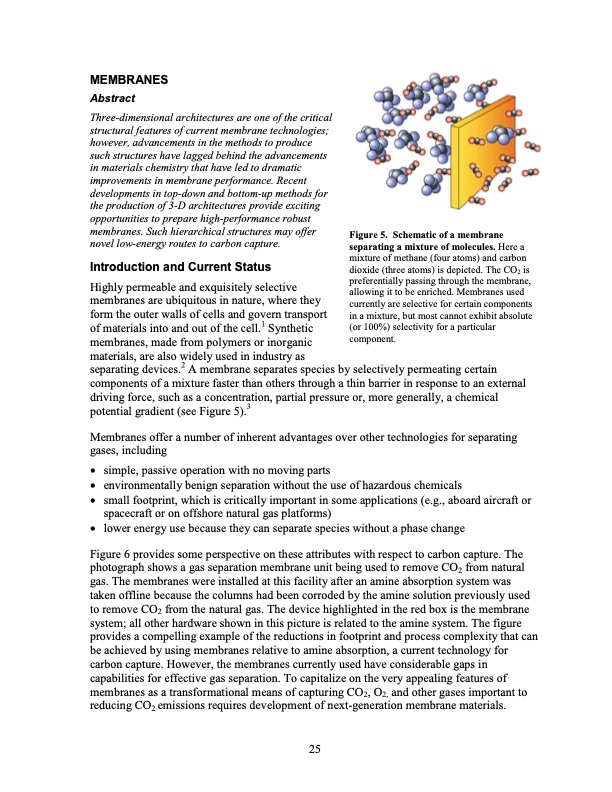
PDF Publication Title:
Text from PDF Page: 039
Figure 5. Schematic of a membrane separating a mixture of molecules. Here a mixture of methane (four atoms) and carbon dioxide (three atoms) is depicted. The CO2 is preferentially passing through the membrane, allowing it to be enriched. Membranes used currently are selective for certain components in a mixture, but most cannot exhibit absolute (or 100%) selectivity for a particular component. MEMBRANES Abstract Three-dimensional architectures are one of the critical structural features of current membrane technologies; however, advancements in the methods to produce such structures have lagged behind the advancements in materials chemistry that have led to dramatic improvements in membrane performance. Recent developments in top-down and bottom-up methods for the production of 3-D architectures provide exciting opportunities to prepare high-performance robust membranes. Such hierarchical structures may offer novel low-energy routes to carbon capture. Introduction and Current Status Highly permeable and exquisitely selective membranes are ubiquitous in nature, where they form the outer walls of cells and govern transport of materials into and out of the cell.1 Synthetic membranes, made from polymers or inorganic materials, are also widely used in industry as separating devices.2 A membrane separates species by selectively permeating certain components of a mixture faster than others through a thin barrier in response to an external driving force, such as a concentration, partial pressure or, more generally, a chemical potential gradient (see Figure 5).3 Membranes offer a number of inherent advantages over other technologies for separating gases, including • simple, passive operation with no moving parts • environmentally benign separation without the use of hazardous chemicals • small footprint, which is critically important in some applications (e.g., aboard aircraft or spacecraft or on offshore natural gas platforms) • lower energy use because they can separate species without a phase change Figure 6 provides some perspective on these attributes with respect to carbon capture. The photograph shows a gas separation membrane unit being used to remove CO2 from natural gas. The membranes were installed at this facility after an amine absorption system was taken offline because the columns had been corroded by the amine solution previously used to remove CO2 from the natural gas. The device highlighted in the red box is the membrane system; all other hardware shown in this picture is related to the amine system. The figure provides a compelling example of the reductions in footprint and process complexity that can be achieved by using membranes relative to amine absorption, a current technology for carbon capture. However, the membranes currently used have considerable gaps in capabilities for effective gas separation. To capitalize on the very appealing features of membranes as a transformational means of capturing CO2, O2, and other gases important to reducing CO2 emissions requires development of next-generation membrane materials. 25PDF Image | 2020 Carbon Capture

PDF Search Title:
2020 Carbon CaptureOriginal File Name Searched:
1291240.pdfDIY PDF Search: Google It | Yahoo | Bing
NFT (Non Fungible Token): Buy our tech, design, development or system NFT and become part of our tech NFT network... More Info
IT XR Project Redstone NFT Available for Sale: NFT for high tech turbine design with one part 3D printed counter-rotating energy turbine. Be part of the future with this NFT. Can be bought and sold but only one design NFT exists. Royalties go to the developer (Infinity) to keep enhancing design and applications... More Info
Infinity Turbine IT XR Project Redstone Design: NFT for sale... NFT for high tech turbine design with one part 3D printed counter-rotating energy turbine. Includes all rights to this turbine design, including license for Fluid Handling Block I and II for the turbine assembly and housing. The NFT includes the blueprints (cad/cam), revenue streams, and all future development of the IT XR Project Redstone... More Info
Infinity Turbine ROT Radial Outflow Turbine 24 Design and Worldwide Rights: NFT for sale... NFT for the ROT 24 energy turbine. Be part of the future with this NFT. This design can be bought and sold but only one design NFT exists. You may manufacture the unit, or get the revenues from its sale from Infinity Turbine. Royalties go to the developer (Infinity) to keep enhancing design and applications... More Info
Infinity Supercritical CO2 10 Liter Extractor Design and Worldwide Rights: The Infinity Supercritical 10L CO2 extractor is for botanical oil extraction, which is rich in terpenes and can produce shelf ready full spectrum oil. With over 5 years of development, this industry leader mature extractor machine has been sold since 2015 and is part of many profitable businesses. The process can also be used for electrowinning, e-waste recycling, and lithium battery recycling, gold mining electronic wastes, precious metals. CO2 can also be used in a reverse fuel cell with nafion to make a gas-to-liquids fuel, such as methanol, ethanol and butanol or ethylene. Supercritical CO2 has also been used for treating nafion to make it more effective catalyst. This NFT is for the purchase of worldwide rights which includes the design. More Info
NFT (Non Fungible Token): Buy our tech, design, development or system NFT and become part of our tech NFT network... More Info
Infinity Turbine Products: Special for this month, any plans are $10,000 for complete Cad/Cam blueprints. License is for one build. Try before you buy a production license. May pay by Bitcoin or other Crypto. Products Page... More Info
| CONTACT TEL: 608-238-6001 Email: greg@infinityturbine.com | RSS | AMP |